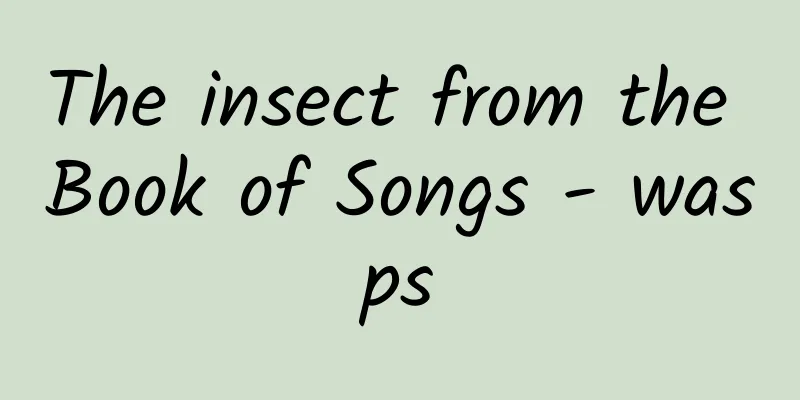The insect from the Book of Songs - wasps

|
The Book of Songs is the earliest collection of poems in my country. It collects 311 poems sung by the people and the royal nobles from the early Western Zhou Dynasty to the middle of the Spring and Autumn Period. Among these poems, there are 19 poems involving the description of insects, including 8 "Feng" poems, 10 "Ya" poems and 1 "Song" poem. Among these chapters, except for two that use the living habits of insects to describe the change of seasons, the rest use insects to express a certain emotion, such as missing, misery, exhortation, satire, rebuke, appreciation, good wishes, etc. The borer has a child, and the wasp carries it. Teach your child to be like a grain. — "The Book of Songs·Xiaoya·Xiaowan" In the process of hard work in the wild, the ancients had already begun to observe nature, but many of their records now seem to be wrong. On the other hand, because science was not developed, the ancients often hoped for divine help or heaven's help when faced with unsolvable problems, which led to the prevalence of superstition in ancient times. Based on "observation", humans added superstitious ideas, and many "transformation" theories were produced in ancient times. For example, we mentioned the saying of "rotten grass turning into fireflies" in the article "Insects from the Book of Songs - Fireflies", and the saying of "the moth has a son, and the wasp carries it" is the same. When the ancients saw the wasp carrying the moth's son back to its nest, they believed that the wasp had males but no females and could not reproduce offspring, so they took the moth's son home to raise. Therefore, for a long time, people have been accustomed to calling adopted sons "moth sons". The Book of Songs, Xiaoya, Xiaowan, uses the wasp's tireless efforts to raise other people's children to symbolize those who are diligent in cultivating virtues, saying that if the king does not work hard to consolidate his position, someone who is diligent in cultivating virtues will replace him. In the Western Han Dynasty, Yang Xiong's "Fa Yan" records: "The son of the moth was killed and met again. The wasp prayed to it, saying, 'Like me, like me.' After a long time, it resembled me." This means that after the wasp took the moth's child home, it kept saying to it, "Like me, like me", and slowly the moth turned into a wasp. After that, similar records were continued in books such as Shuowen Jiezi by Xu Shen of the Eastern Han Dynasty, Maoshi Caomu Niaoshou Chongyu Shu by Lu Ji of the Three Kingdoms, Soushenji by Gan Bao of the Eastern Jin Dynasty, Bowuzhi by Zhang Hua of the Western Jin Dynasty, Piya by Lu Dian of the Song Dynasty, and Shijing Shuyi by Zhu Gongqian of the Yuan Dynasty. Tao Hongjing, a Taoist scholar and medical scientist during the Northern and Southern Dynasties, had doubts about this matter. After many careful observations, he finally discovered that the wasps caught the borers not to turn them into wasps, but to prepare "food" for their children. After the wasps laid eggs in the nest, they caught the borers and put them in the nest. After the larvae hatched, they would have enough food to eat. Wasps not only have females, but also have their own offspring. This incident was recorded by him in his work "Famous Doctors' Records". After observation, he also found that there are many types of wasps, and the nests they built are also different. In the Ming Dynasty Huangfu Xi's "Xie Yi Xin Yu", it is recorded that the borers in the wasp nests are not dead, but they can't move. At this point, the relationship between borers and wasps has basically been figured out. The current scientific explanation is that after wasps catch borers, they inject venom into the borer's body with a poison needle, anesthetize it and then put it into a nest. The borer neither dies nor can escape, and the wasp larvae can eat fresh food after hatching. The development of human language and writing is a long process from few to many, from simple to complex. Words in language also developed gradually. Among them, the method of giving the same name to two similar things was an important means for the ancients to name and create words. When the ancients named a new thing, they would often look at which named thing it was similar to, and then give the new thing a name similar to the old thing. The insect "wafer" got its name from a plant called "fruit gourd". Fruit gourd, also known as trichosanthes, trichosanthes, and hanging melon, is a climbing vine plant with an oval fruit that hangs upside down on the vine through a short stalk. Wang Guowei recorded in "Explanations of the Names of Plants, Insects, Fishes, Birds and Beasts in Erya": "Fruit gourds and fruit gourds mean round and drooping, which is the 'fruit gourd' in the Book of Changes. All fruits on trees and gourds on the ground are actually round and drooping, so all round and drooping things are named fruit gourds... The thin waist of bees also droops like gourds, so they are called fruit gourds." Because the waist of the wasp gourd is very thin, even "about to break", in comparison, its abdomen appears to be thicker and rounder, very much like a hanging small gourd, which corresponds to Wang Guowei's sentence "its abdomen also droops like gourds". Therefore, "waist gourd" comes from "fruit gourd", which is the similarity between the abdomen of the wasp gourd and the shape of the fruit of the fruit gourd. Fabre described it in "The Insect World" like this: "The belly of the wasp is bulging, like a gourd, but it does not hinder its free flight at all." In fact, bees are a group of bees, also known as Pulu, ground bees, bee flies, and thin waist wasps. They belong to the order Hymenoptera, the superfamily Vespoidea, and the family Vespidae. Bees are distributed all over the world, and are more common in tropical areas. Bees are generally about 1.5 cm long, with a black body and some yellow stripes. The first segment of its abdomen is mostly stalk-shaped, and there is often a constriction between the first and second segments. The superfamily Vespoidea includes 12 families, 8 of which are distributed in my country. Although wasps and hornets both belong to the superfamily Vespoidea, they belong to two different families. Wasp is a general term for the superfamily Vespoidea and the family Vespidae. Wasps are social insects that live a collective life. Thousands of wasps live together in a hive. Not only are there queen bees, worker bees and drones, but they also have their own division of labor in this society, each performing their own duties to jointly maintain and operate the collective. However, wasps are solitary bees that live independently and act independently. Therefore, the efficiency of wasps in reproducing offspring is low, and the number of individuals in their population is far less than that of social insects, but wasps are of many species and are the largest group in the superfamily Vespoidea, accounting for about half of the total number of species. The wasp is a holometabolous insect that goes through four stages in its life: egg, larva, pupa and adult. Usually there are 4 or 5 generations a year. Wasps hibernate as pupae, and the overwintering pupae emerge in May and June in late spring and early summer, and the first generation of wasps appears. Male and female wasps live a free life before mating. They forage in the bushes and have no fixed residence. They find a sheltered place to rest at night. The female wasp is a very responsible mother. Once mating is completed, it will prepare a comfortable nest for its children and provide them with sufficient food. After the female wasp has worked tirelessly to build a nest, it will lay an egg in the nest and fix the egg to the nest wall through the egg terminal silk. Then it will work tirelessly to catch prey and store it in the nest. When it thinks that the stored prey is enough to ensure the growth of the larvae, it will seal the nest mouth and then build the next nest... A few days later, the wasp larvae hatch. They fall from the nest wall onto a pile of prey and pierce their mouth needles into the prey to suck out body fluids. After eating one, they eat the second, the third, and so on until all the prey in the nest are sucked out. The mature larvae stop eating and then cocoon and pupate against the inner wall of the nest. Soon they will emerge as wasps. Wasps will use their two hard jaws to bite through the roof and fly out. Then they repeat the behavior of their parents: foraging, mating, nesting, laying eggs, catching prey, and sealing the nest. Before building a nest, wasps must first choose a location. Although almost all wasps build their nests with mud or clay, different species of wasps build their nests in different locations. Some species build their nests underground or in mud walls, some build spherical nests on tree branches, some use holes in plants such as bamboo tubes and small tree holes to build their nests, and some use nests abandoned by bees. The sophistication of the nests built by different wasps varies. Some species simply apply a layer of mud in old nest holes or cracks in the wall, while some species make very delicate mud pot-shaped nests. After making one, they go to another place to make another, and some species make multiple mud nests in the same place in succession. Wasps are solitary bees. In most species, female individuals build their nests alone. In a few species, multiple wasps gather in a small area to build nests together, but they also build their own nests. Mud nests are generally made by wasps with the first segment of their abdomen extended into a stalk-like shape, while for wasps that use bamboo tubes to build nests, the first segment of their abdomen is usually not extended into a stalk-like shape. When laying eggs, they lay their eggs directly on the inner wall of the bamboo tube or reed tube. To make a mud pot-shaped nest, the wasp needs to take water and mud, then shape it, and finally repair it to complete this "work of art". All these tasks are inseparable from the "skillful hands" composed of the upper jaw, forelegs, mouthparts and antennae. In spring and summer, before giving birth, female wasps will first look for a water source, absorb water from it, and then fly to a place with mud, spit water and saliva on the mud, and the dry mud will become wet and soft. After that, the female wasps will insert the two large mandibles on its head into the soft mud, dig up a ball of mud, and then use the two front feet to help gradually make the mud into a ball. At the same time, the two antennae are constantly touching the mud ball to judge the size of the mud ball. Finally, it makes a mud ball of moderate hardness and size, and then uses the two large mandibles and front feet to pick up the mud ball and fly to the nesting point in one breath. Once the water and mud points of the wasps are selected, they will basically not change. Even if they encounter interference, they will still fly there to get water and mud after a while. After arriving at the nesting site, the wasp uses its front legs and upper jaws to clamp the mud ball, and combs the mud ball back and forth to form part of the nest wall. After finishing, the wasp flies away again, and returns with another mud ball a while later, and continues to build a nest on the original basis. In this way, the wasp spent more than an hour to get more than a dozen mud balls, and made a round "small gourd" with a thin neck on the "small gourd". On the thin neck, a straw hat-like flange is built, which looks like a small mud pot, so some people call the snail a mud pot bee. At this time, the first stage of the major project is completed. The second stage is small and delicate work. After the prey fills the clay pot, the wasp has to seal the mouth of the pot and repair the clay pot. The wasp will go to the clay point to get a mud ball, then use its front feet and upper jaw to work together to block the mouth of the pot, and then make another mud ball to fill the flange of the pot mouth. After that, it will use its tentacles to repeatedly check the entire clay pot, add some mud to the places that need to be repaired, and then fly around the house to inspect it again until it is satisfied, and then go to make the next clay pot. After the mud nest is completed, the wasp inserts its abdomen at the entrance and lays an egg. After that, the female wasp's task is to prepare food for the larvae. So what are the foods of wasp larvae? The moth mentioned in "The Book of Songs·Xiaoya·Xiaowan" is its main food. Moth refers to the larvae of the Lepidoptera moth, which is a soft "meat worm". In fact, the prey captured by wasps is not limited to this, but also includes the larvae of various Lepidoptera insects such as sticky insects, geometrid moths, cotton bollworms, cabbage butterflies, and some larvae of coleoptera and sawflies. Some wasps also catch grasshoppers, small spiders, and even larger wall spiders. However, wasps have specific prey, and a wasp nest often only stores the same kind of prey. In order to provide enough food for her babies, the female wasp always flies to the vegetable fields, crops and fields in a hurry to find prey. When she finds a delicious prey, she will immediately bite the prey's neck and sting the prey's abdominal ganglion with the long needle-like ovipositor on her tail, making it anesthetized and non-resisting. Then she easily carries it back to the nest, puts it there and then rushes to find the next prey until she thinks that it is just enough for the larvae to eat and pupate. This is the magic of the wasp: it can predict the larvae's appetite. Therefore, the number of prey that the wasp puts in each nest is not fixed. The number of prey with smaller individuals is more, and the number of prey with larger individuals is less, generally between 3 and 30. Therefore, the wasp larvae can "rest assured" to eat them one by one, without any surplus or shortage. The venom of the wasp contains certain neurotoxins that act on the nervous system of the prey, that is, components that can paralyze the host. The paralytic effect of the wasp venom depends on the protein component, and its target is located in the central nervous system. The amount of toxins discharged by the sting of the wasp is also "carefully calculated" when hunting. The size of the prey is different, and the amount of toxins discharged is also different, which can paralyze the prey as soon as possible without killing it in a short time. Those prey are only paralyzed in the motor nerves and cannot move, but they will not rot or die, but will always be in a state of sleep. In this way, the wasp larvae can always eat fresh and delicious food and just complete their growth and development. The physiological functions of the prey paralyzed by the wasp venom are reduced, and they cannot move in the humid nest, so they are very easy to be infected with bacteria. Therefore, the wasp venom does not contain phenoloxidase, which has a strong destructive effect on prey, nor does it contain phenoloxidase inhibitors that interfere with the host's immune response. This is the result of natural selection during the evolution of wasps. There is a relationship of mutual dependence and mutual restraint between organisms. The often mentioned "one thing conquers another" refers to the restraint relationship between organisms, such as the mantis stalks the cicada, the oriole is behind, the rabbit jumps and the falcon falls, the big fish eats the small fish, the small fish eats the shrimp, and so on. These restraint relationships form a food chain with several links, such as small fish eat plankton, big fish eat small fish, and birds eat fish. The occurrence and development of life is completed through the energy flow and nutrient exchange of the food chain. Predation refers to one organism feeding on another organism. Broadly speaking, there are three types of predation. The first is typical predation: the predator eats the prey after attacking and killing it; the second is herbivorous predation: the predator gradually eats the plant, or only eats part of the plant; the third is parasitism: the predator parasitizes on the body or outside of the prey, and survives and lives by taking nutrients from the host. Among parasitism, there is also a special parasitic phenomenon, in which the parasite can always cause the death of the host. This phenomenon is called parasitoid. Parasitoid phenomenon is extremely common in insects. All insects parasitize on insects. The relationship between wasps and stem borers is a parasitoid. Female wasps lay eggs on the surface or body of the host. The hatched larvae feed on the host's body fluids or tissues and gradually kill the host. The basic principle of biological control is to use the relationship between mutualism and mutual restraint between organisms, and use organisms that have mutual restraint on plant pests to control diseases and insect pests or reduce their harm. "Using insects to control insects" means using predatory or parasitic natural enemies to control agricultural and forestry pests. It can not only change the composition of biological communities and directly eliminate a large number of pests, but also is safe for humans and animals, does not kill natural enemies, does not pollute the environment, is not restricted by terrain, has a long-term effect, and will not cause pests to become rampant again and form resistance. It is an important part of comprehensive control. The idea of "using insects to control insects" has a long history in my country. Shen Kuo of the Northern Song Dynasty recorded the effectiveness of ground beetles in preying on pests in "Mengxi Bitan·Miscellaneous Magazine 1"; Wang Chong of the Eastern Han Dynasty recorded "spider spinning silk webs to catch insects, and mantis stretching its arms to catch cicadas" in "Lunheng·Wu Shi Pian"; Ji Han of the Jin Dynasty recorded the use of yellow macaque ants to control citrus pests in "Nanfang Caomu Zhuang". Parasitic wasps are important natural enemy insects that are widely used and effective in the current "using insects to control insects" strategy, such as using trichogrammatids to control corn borers and pine caterpillars; using Aphididae to control whiteflies; using Scleroderma guanii to control longhorn beetles; using Aphididae to control aphids; using Chrysocytisus chinensis to control pink bollworms; using Chou's gnawing wasps to control gypsy moths; etc. At present, many natural enemy insects have been produced in factories. In nature, the breeding season of wasps coincides with the peak period of Lepidoptera, and the life cycle rhythm of wasps corresponds to the annual cycle of food changes. There are many species of wasps, with a large population and a large prey volume. Therefore, wasps play a direct natural control role on the population of many agricultural and forestry pests, and are an important type of natural enemy insect. As early as the 1970s, Zhenhai area in Zhejiang Province, my country used a local wasp to eliminate farmland pests. Each female wasp catches more than 100 pests every day during the egg-laying period from late June to early July, which protects local crops well. The wasps mentioned by the ancients may not just be the insects of the family Ichthyoptera that we are talking about now. Because some species of mud wasps and wasps are very similar in morphology and living habits, such as both are hunting bees, solitary, and both adults feed on nectar. They also have behaviors such as nesting, hunting, and storing insects, so the ancients are very likely to confuse mud wasps and wasps. So what are the differences between mud wasps and wasps? In fact, although both belong to the order Hymenoptera, they belong to different superfamilies. Wasps belong to the superfamily Vespoidea, while mud wasps belong to the superfamily Sphaeroidea. The wings of the superfamily Vespoidea are all folded, while the wings of the superfamily Sphaeroidea are very flat. Mud wasps are widely distributed, even in the Arctic Circle, with the largest number in tropical and subtropical areas. There are about 9,000 known species in the world. Mud wasps have a very wide hunting range, and their prey species are much more numerous than those of wasps, including insects of the orders Lepidoptera, Coleoptera, Orthoptera, Homoptera, Hemiptera, Diptera, Hymenoptera, Blattodea, Ephemeroptera, Odonata, Mantodea, and Psoralea, as well as other arthropods such as spiders and scorpions. The hunting species range varies greatly depending on the genus and species. Mud wasps are very smart insects. They also know the food intake of their larvae. The number of prey they capture varies according to the size of the prey, which is very similar to wasps. Most mud wasps build their nests in the soil. The genera of sand wasps and wall wasps use a mixture of soil and saliva to build hard, cement-like nests; the genera of short-stalked wasps use natural caves on the ground or old nests of other insects; a few small-lipped mud wasps build their nests in tree branches or hollow stems. Like wasps, mud wasps usually live freely and do not have fixed nests. After mating, the female wasp will perform a series of behaviors to raise the larvae: building a nest, capturing and anesthetizing prey, carrying prey to the nest chamber, laying eggs on the prey, closing the nest chamber, etc. But the order varies depending on the evolutionary level of the group. Most mud wasp species first build a nest, then capture prey many times and bring it back to the nest after anesthesia, then lay eggs on one of the prey, and finally close the nest chamber. After the larvae hatch, they feed on the prey until they mature and pupate. A few mud wasp species are progressive feeders, such as the soft-haired sand mud wasp. After the nest is built, the female wasp first captures a prey and puts it in the nest, then lays an egg on the prey, but does not close the nest entrance. After the larvae hatch, they first feed on this prey. After the larvae have eaten the first prey, the female bee will catch another prey and put it in the nest. The larvae will continue to eat, and the female bee will continue to replenish the feed until the larvae are mature and no longer eat, and then the female bee will seal the nest. A female bee can usually provide continuous food to larvae in three nests at the same time. |
<<: Do mice like rice or cheese more?
>>: Can blood type predict cancer? What you never expected is...
Recommend
Don't touch it! There are a lot of these black "fruits" on the streets, and it's easy to get "infected"
When this season comes every year, many roads wil...
A trembling frog leg actually led to the invention of the battery?
On October 17, 2024, Hou Yimin, director of the I...
H5 fission communication skills that can sweep the screen!
In recent years, H5 has gone from being easy to f...
A comprehensive analysis of Vatti: A win-win-win situation of “leveraging marketing” during the World Cup!
As early as the early morning of July 11, France ...
Confirmed! Apple will completely ban 32-bit applications, 200,000 apps will be removed from the shelves
With the release of iOS 11 this year, Apple has d...
Facing Skyworth's paper-thin OLED TV, can Hisense, which sticks to ULED, have the last laugh?
At present, the most intense competition in TV pa...
Is staying up late really that unhealthy? Actually...
Hello, this is Science Popularization China. Toda...
Millions of IPs create science and technology talents to strengthen the country丨Deepen digital transformation to help build intelligent rail transit growth
At the end of 2021, the Ministry of Transport iss...
Why is the market still flocking to Apple Watch despite its sky-high pre-sale prices?
Apple Watch officially started accepting pre-orde...
A new AI operating system is emerging, and Android may withdraw from China in the future
At present, many domestic mobile phone brands cla...
When doing new media marketing in 2019, these 5 trends must be paid attention to!
There were many successful marketing cases in 201...
What happened to WeChat stopping its services in India? Why WeChat stopped serving India
Some Indian users said that they were forced to l...
How to come up with marketing ideas that go viral? (superior)
In the 5th century BC, there was a most respected...
Appendix, wisdom teeth, coccyx...Why do humans always have some strange evolutionary remnants?
© Getty Images Leviathan Press: It's said tha...
Surprise: Hackers love to set simple passwords
When we are online, we are always afraid that hack...









